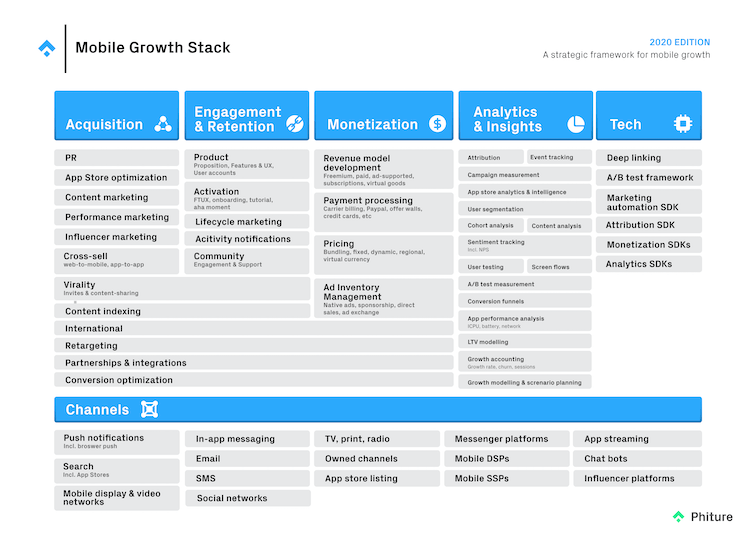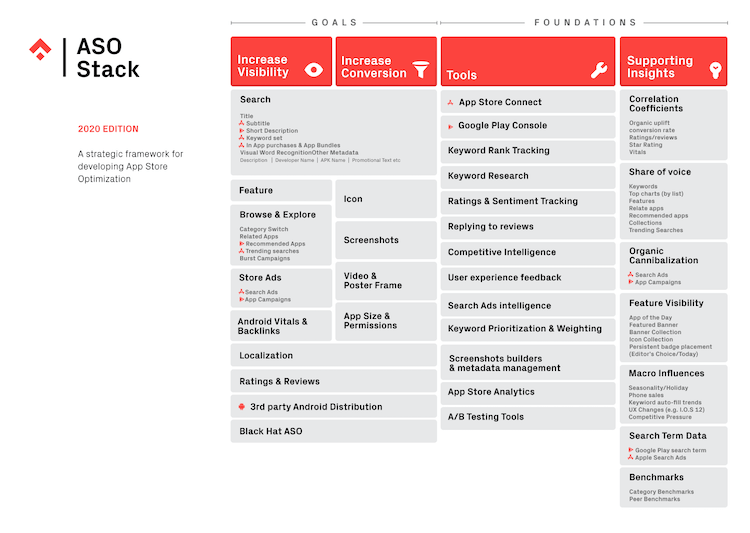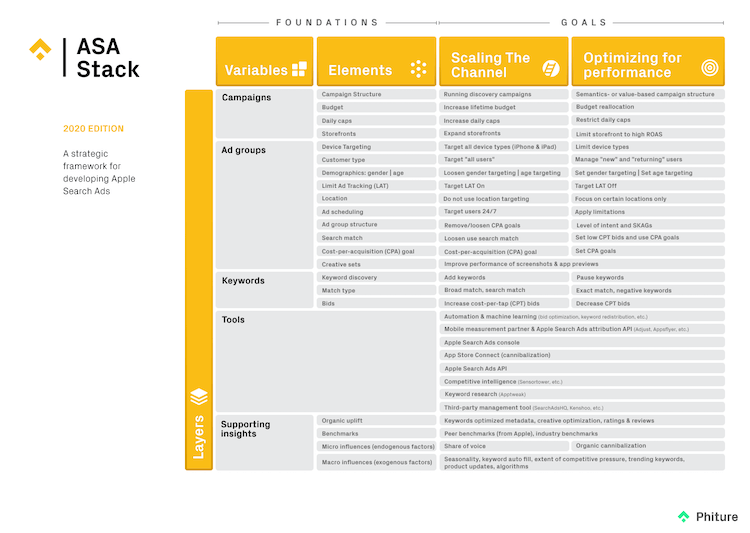
This article first appeared on Business of Apps
At Phiture, we are strong believers in frameworks and employ them regularly in our work. It’s also a key tenet of our approach to develop and publish new frameworks in the field of mobile growth; to share them with the professional community and engage in discourse with our peers with a goal to cultivate mutual understanding, knowledge exchange, and to progress the work that we do as growth practitioners.
In this article, I’ll detail a few of the frameworks that we’ve published over the past few years and briefly explain how they are used in our consulting practice and across the industry.
The Case for Frameworks
So, what exactly is a framework? Broadly speaking, it’s a structure that forms a sound basis for further work. A useful framework provides a structure for thinking about a particular topic and facilitates a shared understanding or approach. Our frameworks are the synthesis of our ideas and experience into a working model that can be understood and deployed by others in a systematic way.
A framework is just a tool; whether it’s useful to employ it in a particular context is largely subjective. ‘Trying on’ a framework, in much the same way as one might don an outfit, can be a helpful way to progress a planning session or to tackle new or existing challenges. It’s not necessary to tie yourself to any specific way of thinking and teams should not feel obligated to stick with a framework if, in the course of a project, their thinking or practice evolves to the point where the framework feels limiting rather than enabling. If it’s useful in aligning or structuring thinking at any particular point in the journey, the framework has done its job.
Selected Phiture Frameworks
The Mobile Growth Stack
Our oldest and most well-known framework, the Mobile Growth Stack, is currently in its third iteration. The stack was born from the efforts of Phiture’s co-founder, Andy Carvell, as he endeavored to communicate the levers for growth of a mobile application to the leadership team at SoundCloud and thus secure buy-in for his mobile growth initiatives. Andy published the first version of the stack in 2014 and the framework was widely hailed as a valuable tool for strategic planning.
The Mobile Growth Stack Framework is a one-page ‘cheat sheet’ for mobile growth. It provides growth professionals with a comprehensive set of activities and channels that can be combined in any number of configurations to drive acquisition, engagement and retention, and monetization for a mobile app or game.
One common misconception of the stack is that all of its elements must be applied when it’s deployed as a growth strategy — not only is this impossible, but it would also be suboptimal. Strategy is about making tradeoffs. The stack encourages the consideration of all of its elements with the aim of facilitating decisions on which elements to focus on at any given point in time, based on the strengths and resources of the team and the specifics of the app they are trying to grow.
At Phiture, we use the Mobile Growth Stack Framework regularly in our work and help our clients apply the stack to develop and refine a holistic growth strategy.
The ASO Stack
Every activity in the Mobile Growth Stack can be broken down into a lot more detail: that’s exactly what we did with App Store Optimization. Our ASO Stack zooms in on the topics of organic acquisition and app store conversion rate optimization and breaks down the components that can help marketers nail the tricky but essential task of merchandising their apps effectively in the Apple App Store and Google Play Store.
ASO has two core activities: increasing search visibility by ranking highly for a set of keywords that the target audience is searching for (which also involves regular keyword research) and increasing the conversion rate from impression to install on the app store product listing pages themselves.
We employ two additional frameworks to help our clients with these core activities: the Keyword Optimization Cycle and the CRO Loop.
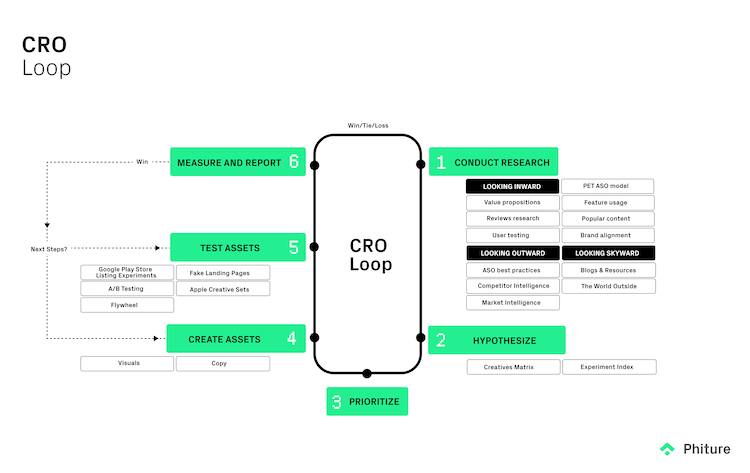
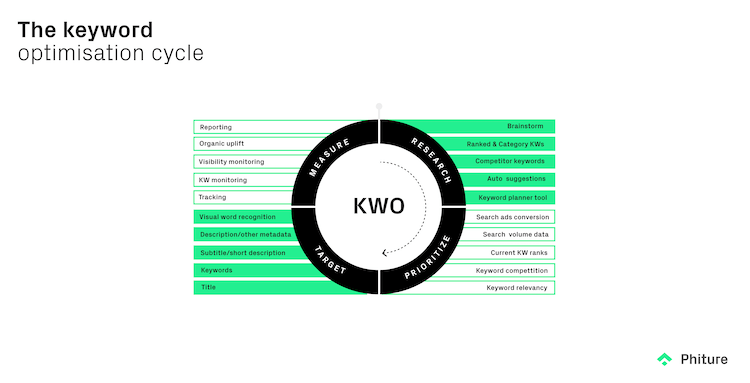
The Apple Search Ads (ASA) Stack is a framework designed to help ASA practitioners of a mobile product or service develop and evolve a strategy for Apple Search Ads. The ASA Stack’s objective is to provide user acquisition marketers with a holistic view of Apple Search Ads. It shows them how they can develop a comprehensive, strategic approach to grow the user base and/or optimize for performance. The stack can be applied at any stage during a product’s lifecycle and to many different apps, although some elements of the stack could become more relevant at different stages of the business lifecycle.
RRF
A refreshingly simple framework without a ‘stack’ in sight, the RRF Framework provides a formula for prioritizing the development of push notifications based on their projected impact.
The formula is simple: Impact = Reach x Relevance x Frequency. It’s derived from Phiture co-founders, Andy and Moritz, and their combined experience building and optimizing a real-time notification system from scratch at SoundCloud that increased 30-day rolling user retention by five percentage points (this is a huge uplift for a notoriously hard-to-move metric).

Reach: How many users will qualify for a notification type? The most impactful notifications have the potential to reach the entire user base.
Relevance: The more relevant the notification, the most likely users will engage with it. Ensure that the content is tailored to the explicit or implicit signals from the user.
Frequency: Events that can trigger notifications occur with different frequency, often dictated by external factors. High-frequency events are fundamentally desirable.
Table of Contents

